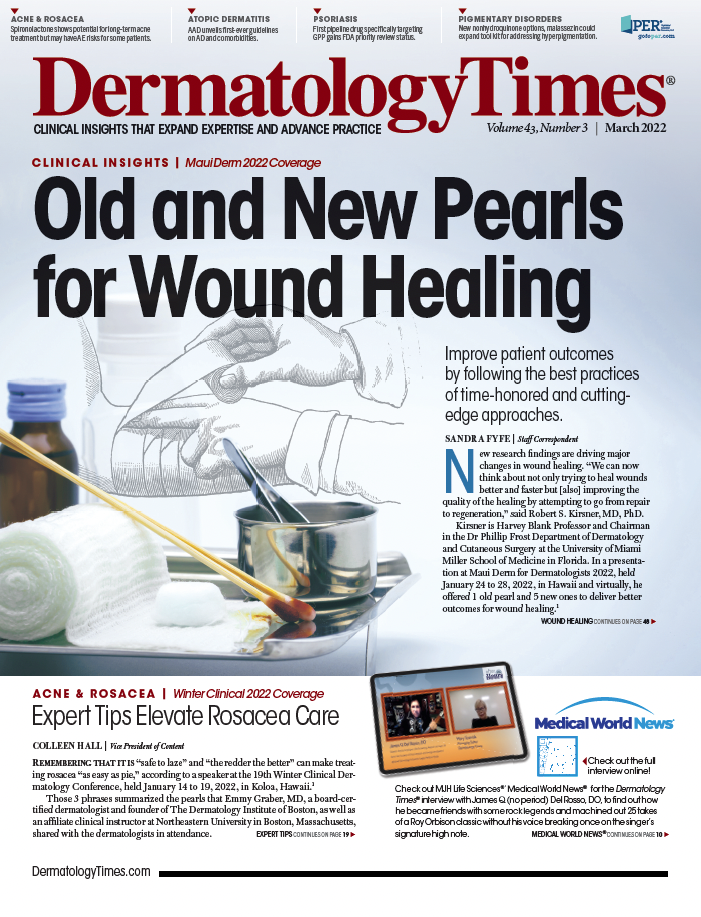- Case-Based Roundtable
- General Dermatology
- Eczema
- Chronic Hand Eczema
- Alopecia
- Aesthetics
- Vitiligo
- COVID-19
- Actinic Keratosis
- Precision Medicine and Biologics
- Rare Disease
- Wound Care
- Rosacea
- Psoriasis
- Psoriatic Arthritis
- Atopic Dermatitis
- Melasma
- NP and PA
- Skin Cancer
- Hidradenitis Suppurativa
- Drug Watch
- Pigmentary Disorders
- Acne
- Pediatric Dermatology
- Practice Management
- Prurigo Nodularis
- Buy-and-Bill
Publication
Article
Dermatology Times
Focusing on Toners and Astringents
Author(s):
In this month's Cosmetic Conundrum, Zoe Diana Draelos, MD, discusses the differences between astringents and toners and highlights the ideal persons who should use each product.
Q: What is an astringent?
An astringent is a water-based product used after cleansing to remove cosmetics and cleanser residue from the face. Astringents were developed when most people cleaned their face with well water, which contained a high mineral content. The minerals would combine with homemade soap to create a film, sometimes called soap scum, which would deposit on the face. This soap residue was irritating to the skin. In modern cleansers that contain chelating agents, soap scum is no longer a problem, yet astringents persist in the marketplace. Currently, astringents are largely used to remove sebum that may not have been removed with a mild cleanser. Many astringents now contain alcohol, salicylic acid, glycolic acid, and other exfoliating agents designed to remove excess skin sebum.
Q: What is a toner?
A toner is a water-based skin-care product designed to remove cosmetics and cleanser residue, which is identical to the function of astringents. However, toners have become diversified such that they are available for all different skin types with different needs. Toners for oily skin are similar to astringents in that they contain alcohol, salicylic acid, or witch hazel to dry skin further after cleansing. Toners for dry skin contain humectants such as glycerin, hyaluronic acid, or propylene glycol to function as moisturizers, increasing the skin’s water-holding capacity. Toners are also available for sen- sitive skin based on anti-inflammatory ingredients, such as aloe, allantoin, and bisabolol. Antiaging toners may deliver cosmeceutical ingredients designed to induce topical vitamins, topical antioxidants, or cosmeceutical ingredients designed to induce pigment lightening. Finally, toners may contain sensates, such as camphor and menthol, to create a cooling feeling and the impression of skin tightness. In short, a toner is a product applied after cleansing and before moisturization to provide some added skin benefit.
Q: Who should use an astringent?
Astringents are probably best used by patients requiring OTC acne treatment. The most useful astringents contain salicylic acid, which is a monographed OTC acne ingredient, inducing exfoliation in the oily milieu of the pore. Salicylic acid also can function as an anti-inflammatory. Salicylic acid astringents put on a cotton ball can be wiped over the face following cleansing to deliver some acne benefits. Witch hazel astringents can also be useful in delivering a drying and antibacterial effect to facial pustules and papules or can be applied only to the T-zone to achieve added sebum control. Thus, astringents can be used as OTC adjunctive acne therapy either along with prescription medications or during the maintenance phase of treatment.
Q: Who should use a toner?
Toners have morphed into ubiquitous products that can be used by all for a variety of reasons, as mentioned above. In reality, toners are not necessary, as all the uses of a toner could be handled by either serums or moisturizers, yet toners remain part of every cosmetic counter skin-care routine. Toners may be beneficial for persons with oily skin who wish to apply added ingredients to the face in a nonoily base. For example, skin-lightening ingredients used for acne postinflammatory hyperpigmentation, such as arbutin and niacinamide, can be applied as a nongreasy liquid. For persons with dry skin, a layer of hyaluronic acid can be applied in the form of a toner under a traditional moisturizer to enhance the water-holding capacity of the skin. There may be situations where a toner will provide an added cosmetic benefit.






